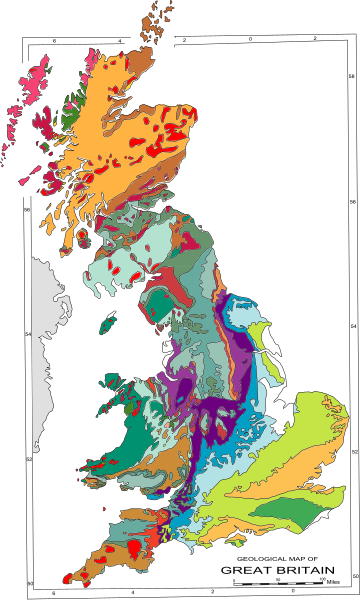Geology of Great Britain
The geology of Great Britain is varied. With its eventful geological history, Great Britain has a variety of landscapes. Rocks of almost all geological ages can be seen, from the Archaean onwards.
| Geology of Great Britain | |||
|---|---|---|---|
| Quaternary | 
| ||
| Paleogene / Neogene (Tertiary) | |||
| Cretaceous | |||
| Lower Cretaceous | |||
| middle/upper Jurassic | |||
| lower Jurassic | |||
| upper Triassic | |||
| lower Triassic | |||
| upper Permian | |||
| lower Permian | |||
| Upper Carboniferous (coal measures) | |||
| Middle Carboniferous | |||
| Lower Carboniferous (limestone) | |||
| Devonian | |||
| Ordovician / Silurian | |||
| Cambrian | |||
| Neoproterozoic | |||
| Proterozoic (upper Precambrian) | |||
| Lewisian (lower Precambrian) | |||
| granite | |||
| Paleogene volcanics | |||
Overview
changeSeismology shows the crust of the Earth below Great Britain is from 27 to 35 km (17 to 22 miles) thick.
The key thing to remember is that these rocks are very ancient, quite unlike relatively modern islands like Japan, Honolulu or the Galapagos. These are relatively new islands which are volcanic in origin. Quite different are the British Isles, which are formed from extremely ancient rocks which were part of ancient continents. That is why you can find almost any rocks known on Earth somewhere in the British Isles, but volcanic islands are limited in their rocks.[1]
The island of Great Britain can be thought of as being in two halves stuck together. One half is Scotland plus its various islands. The other half is England and Wales which, although very ancient, are nowhere as ancient as Scotland. The division runs across Ireland as well. Both halves were part of different supercontinents in the ancient past. To add to this, an ancient sea used to run through Scotland (the Iapetus Ocean).[2]
The line where the ocean used to be is called the Iapetus Suture. Where it stands now, an ancient ocean once stood. The two halves were separated by 7,000 km (4,300 mi) of ocean. The Iapetus Suture runs from the Solway Firth to Lindisfarne.[3]
The oldest surface rocks are the isles in north west Scotland. They are more than half as old as the planet. The basement rocks are the Lewisian complex or Lewisian gneiss. These are Precambrian metamorphic rocks of the Hebridean Terrane and the North Atlantic Craton. These rocks are of Archaean and Paleoproterozoic age, ranging from 3.0–1.7 billion years (Ga).
The youngest rocks are found in south east England. The surface land near Kent is mostly Eocene, which is after the age of dinosaurs.
Bedrock and past volcanism
changeThe bedrock geology consists of a complex mix of generally older metamorphic rocks. They are overlain by varying sedimentary rocks. Igneous rocks have been intruded at different times (squeezed through pre-existing rocks). The complexity of Great Britain's geology is due to its having plate tectonic processes over a very long period of time. Changing latitude and sea levels have been important: the rocks have crossed the equator during their time. Continental collisions have affected the geology, with major faulting and folding during orogeny (mountain-building periods). During orogeny, there were volcanoes and metamorphism of existing rocks.[4]
Resources
changeThe rocks have left resources which are never found on the more recent volcanic islands. In contrast, almost every metal found on Earth can be found in some quantity on the British Isles. Originally, copper and tin were mined by the Romans, but small quantities of most metals can be found. This is becoming important, as it prevents larger countries from having a monopoly of rare metals.
References
change- ↑ Toghill, Peter 2000. The Geology of Britain: an introduction. Shrewsbury: Swan Hill Press. ISBN 1-85310-890-1
- ↑ Bennison G.M. & Wright A.E. 1969. The geological history of the British Isles. London: Edward Arnold. ISBN 0-7131-2226-9
- ↑ Hill, John (7 February 2007). "Palaeozoic History of the UK - Part 1: Cambrian to Silurian". GeologyRocks. Archived from the original on 23 March 2010. Retrieved 16 August 2009.
- ↑ Woodcock N.H. & Strachan R.A. 2002. Geological history of Britain and Ireland. Oxford: Blackwell Science. pp. viii+423. ISBN 0-632-03656-7